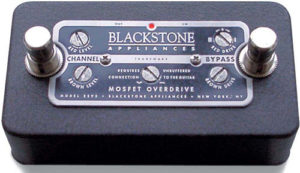
Reeves Gabrels Blackstone Appliances Mosfet Overdrive
“It’s hard to narrow it down to one thing, because when the Pro Co RAT came along, it changed everything,” says Cure guitarist and former Bowie collaborator Reeves Gabrels. “Finally, there was a pedal that didn’t sound like a fuzz box. You see, I used to like to set my amps clean, and I was forever looking for a pedal that would sound like a stack-style preamp-y overdrive. I tried an Ibanez Tube Screamer and a RAT at the same time, and the RAT was the one. It’s always distortion pedals for me, because I feel you can get so many things that listeners think are some other effect with distortion—just by the spin you put on the ball, or whether you get a harmonic with the side of your pick, or the way you play over the pickup. I see distortion as one of the primary colors of guitar.”
Gabrels found the Mosfet Overdrive in an almost microscopic-sized ad in the back of a magazine around 2001, a couple of years after he had left David Bowie‘s band and was embarking on his solo career.
“It reminded me of the transformer from an old electric train set I had as a kid, so I had to have it,” he says.
That pedal became one of Gabrels’ indispensable sonic partners, and even today, he ensures he has one in each of his houses, stores one at The Cure’s rehearsal studio, and packs one into a briefcase for use wherever he roams. It first saw action his solo albums Ulysses (Della Notte) (1999), live… late… loud (2003), Rockonica (2005), and Reeves Gabrels and His Imaginary Friends (2015), and it has been an essential component of his session work and his live and studio performances with The Cure.
The two-channel Mosfet Overdrive is the brainchild of New York musician Jon Blackstone, who, at least as mythology has it, engineered and constructs the pedals on his kitchen table. He has stated the idea for the Mosfet Overdrive came to him in the ’70s, but it wasn’t until he really studied solid-state circuitry in the ’80s and ’90s that the pedal surged into reality, and he started his company around it in 1998. (“It turns out that it actually doesn’t hurt to know what the heck you’re doing,” he told effectsdatabase.com in 2012.) At present, he continues to make just this one pedal and sells them direct from his website.
“I read that Jon devised the pedal to help players deal with the house amps at Manhattan clubs,” says Gabrels. “Back in the ’90s, I remember, most clubs didn’t want you bringing your stuff in. You’d show up, and there would be a Fender Twin—or maybe something smaller like a Fender Deluxe or a Peavey—but usually they were amps that didn’t provide you with any gain. So the intention of the Mosfet Overdrive is that you can run it into a clean amp and get a good crunch rhythm with one channel and a more distorted sound with the other channel. I typically run the Red channel’s Drive knob between three and four o’clock, and the Brown channel’s Drive at noon. I’ll vary the setting of each channel’s Level knob, depending on how the amp I’m using reacts to being hit hard. One of my tricks is to set the Brown channel a little below unity gain so that you have a dB or two of headroom before the amp’s preamp stage starts to compress—which happens faster on Vox AC30s than, say, Fender Twins. You could say that I now look at the world of amplifiers through the lens of the Blackstone.”


